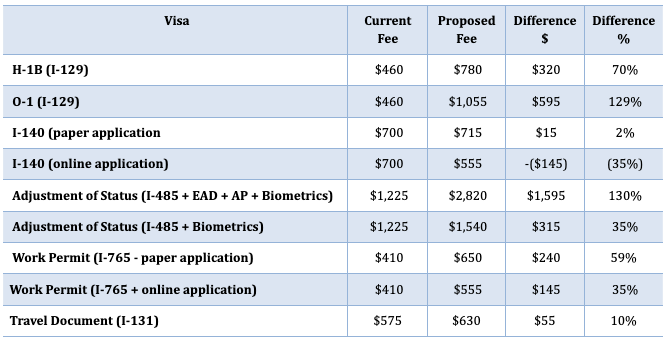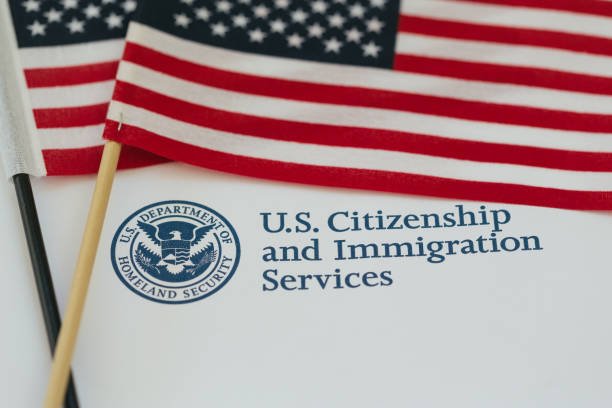USCIS proposes dramatic filing fees raise.
How would that affect employment-based visa applicants?
On January 4, 2023, the USCIS released a Notice of Proposed Rulemaking, announcing the application fee increase across the board. The fee increases can range from 40% to 200%, which will affect employment-based, family-based, and even humanitarian immigration applications.
There was an attempt to raise immigration fees back in 2020, but the increase was significant, and the proposal backfired. The final rule was challenged based on the lack of explanation for the dramatic change in the financial needs of the USCIS. Apparently, USCIS learned its lesson and didn’t commit the same floss this year. The agency invested a great effort and prepared a highly detailed proposal to give purpose to each dollar increase.
U.S. Citizenship and Immigration Services justify the proposed fee increase as a way to restructure the agency’s operational capabilities since the agency relies 96% on provisions coming from filing fees, and the USCIS has not introduced any new fees since 2016.
The new proposed fee structure is expected to generate $5.2 billion per year, and an additional $1.2 billion of premium processing can be added to that, bringing to a projected amount of $6.4 billion per year on average. The USCIS Executive Director Ur M. Jaddou declared that the proposed rule would allow the USCIS to recover and improve customer service and workload management to minimize backlogs.
Key points from the USCIS proposed fee rule
- Premium processing fee: changing the adjudication time from 15 calendar days to 15 business days.
- Asylum Program Fee: this is a new surcharge fee to be paid by employers that file I-129 and I-140. This fee aims to help fund asylum and humanitarian relief programs.
- Online vs. Paper applications: certain forms will have lower fees for online filing. The USCIS wants to encourage online filing over paper.
- Adjustment of Status: will now require 3 separate fees – I-485 (Application to Register Permanent Residence or Adjust Status), I-765 (Application for Employment Authorization), and I-131 (Application for Travel Document).
- H-1B cap registration: changing from a nominal fee ($10) to a significant one ($215).
- Biometrics: costs will be incorporated in the mail application fee.
The significant impact of USCIS’s proposed fee changes
Even though we can see higher fees across the board, this action will mainly impact foreign nationals in the employment-based green card process. The fee increase could make it more expensive for companies to sponsor foreign workers. Additionally, some applicants may be unable to pay the increased fees, making it more challenging to obtain a visa.
The proposed rule includes a fee of $600 to applicants of Form I-129 (Petition for a Nonimmigrant Worker) and I-140 (Immigrant Petition for Alien Worker). This is an additional fee to be added to the fee increase and is intended to be directed to the USCIS Asylum Program.
We can clearly see a policy shift that enhances the burden on those who can afford over those categories that most likely need help in order to pay, such as asylum applicants. The additional fee mentioned above will serve to offset the costs of the incoming asylum population due to the recent world’s economic, social, and political circumstances.
Implications of a fee increase on the green card process
Besides the significant increase in the fees to file Form I-129 and I-140. The hike will be disproportionately on the adjustment of status for those who request employment authorization documents or travel permits or apply for children simultaneously.
Currently, certain green card applicants can have fees such as Form I-765, and Form I-131 waived with a pending I-485 application. The new proposition intends to revoke the waiver possibility and charge to filing forms I-485, I-765, and I-131 separately, which would increase the total cost for an individual to adjust status substantially, going from $1,225 to $2,820.
Another implication USCIS raising the fees can have on the children’s application, which will no longer have reduced fees when filing along with the parent’s application, which means that children will pay the same as the parents. This represents an increase of 105%.
H-1B visa pre-registration fee
H-1B petitions pre-registration is where the most noticeable increase can be seen. The USCIS states that the rise reflects the costs needed to aid this visa category system. The current pre-registration fee is $10, and the new fee would be $215, representing a 2050% increase.
There are a few things that need to be taken into consideration here.
On March 1st of each year, the USCIS opens registration for the H-1B lottery. The H-1B visa lottery is a process used by the USCIS to allocate a limited number of H-1B visas to foreign workers in high-skilled jobs since this is a highly competitive category where demand often far exceeds the available visas.
The H-1B cap is the U.S. government’s limit of H-1B visas issued each fiscal year. The cap is set by Congress and is currently set at 65,000 visas for regular H-1B applicants and 20,000 for those with a U.S. advanced degree.
The H-1B cap is intended to regulate the number of high-skilled foreign workers who can enter the U.S. each year and ensure a balanced supply and demand for skilled labor. The cap is usually reached within the first week of the filing period, leading to the use of a lottery system to select the petitions for processing randomly.
Considering the timeline, it is doubtful that the U.S. Citizenship and Immigration Services rulemaking process will be complete by March 1st, 2023. On the one hand, the chances are very high that the H-1B cap registration fee will remain unchanged for 2023, increasing only in 2024. On the other hand, the fee increase may affect those visa petitions selected in the H-1B annual lottery.
The new I-129 structure for different visa applications
One significant difference from the current fee structure is the differentiation of fees for I-129 petitions, where currently, the baseline is $460, and the new proposed feed will vary depending on the visa classification, as follows:

USCIS proposed fee increase by type of application
This chart summarizes the current and proposed fees for the most common employment-based immigration petitions.

Premium Processing and the processing time change
Expanding premium processing time from 15 calendar days to 15 business days is not new. In fact, this rule was proposed in 2020 under the Trump administration fee increase proposal, which was later rejected in Court.
What to expect from the USCIS fee increase proposal?
To enact such a significant change, the USCIS must follow a specific procedure required by the Administrative Procedures Act. The first step was publishing the proposed rule on January 4, 2023.
The second step is to start a mandatory 60-day public comment period. During this time, the USCIS seeks to collect comments from the public regarding the proposed rule. The commenting period will end on March 6. Then the USCIS can take the appropriate measures based on the comments. They can keep the rule as it is and modify or withdraw the proposal.
The USCIS must publish the final rule within 30 days after the end of the commenting phase. Once published, state the date on which the rule will be in effect. This can take from 30 days to several months.
Conclusion
We anticipate that the USCIS will receive a high volume of feedback regarding this increase proposal. Considering all the facts presented by the agency, which support the need for an increase to sustain and improve the immigration services provided, it’s hard to predict whether the agency will consider reducing the proposed expansion. Also, it is unclear whether litigation may arise, as it happened in 2020, which could lead to an implementation delay.
In the middle of uncertainty regarding a possible skyrocketing fee increase, if you are ready to move with your immigration process, it is better to start sooner than later to ensure more affordable fees.
If you need to get your situation evaluated by an expert, don’t waste any time and contact us.
FAQ:
Why does the USCIS need to raise application fees?
The agency justifies the proposed fee increase as a way to restructure the agency’s operational capabilities and says that the current fees are insufficient to cover operating costs to adjudicate immigration benefits timely.As a Federal Agency, Isn’t the USCIS funded by the United States Congress?
Unlike other government agencies, the USCIS is not funded by taxpayers. Therefore, the agency relays 96% of provisions coming from filing fees.Why are some of the proposed fees relatively different for the same if used online instead of paper filing?
The USCIS wants to encourage online filing in order to increase the efficiency rate when it comes to the adjudication process.What is the argument behind the rise in the H-1B registration fee?
The H-1B registration fee is paid separately from the petition filing fee. Due to a lack of USCIS data to precisely estimate the cost of registrations, the initial fee imposed was $10. However, at the time, the Department of Homeland Security (DHS) stated that the fee would be reviewed in the future. For the 2023 proposal, the DHS proposed a new fee of $215, a substantial increase compared to the current fee, but the agency says that the raise is necessary to cover the cost of operations.What is the new $600 fee for certain employment-based visa petitions?
This is a new surcharge fee to be paid by employers that file I-129 and I-140. This fee aims to help fund asylum and humanitarian relief programs.What is the change in the premium processing time?
The new USCIS’ proposed rule will expand premium processing time from 15 calendar days to 15 business days.What is the most significant change for the adjustment of status applicants under the new fee regulation?
Applicants will no longer be able to pay one fee to apply for I-485 + I-765 + I-131. Under the new rule, AOS applicants must pay separate application fees for each form. Currently, the cost to file I-485, I-765, and I-131, plus biometric services, is $1,125. The new fee will be I-485 + biometric services ($1,540), I-765 (online $555 / paper filing $650), and I-131 ($630). Total $2,725 or $2,820, depending on how you opt to file form I-765.









